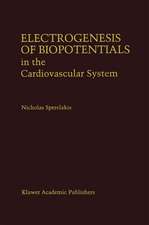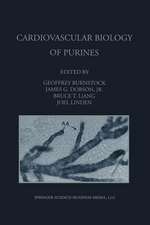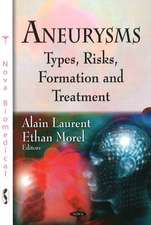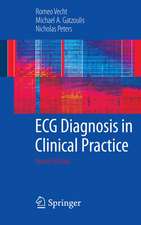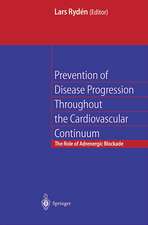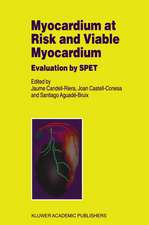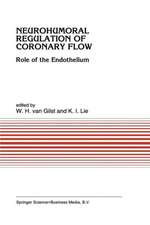The Slow Inward Current and Cardiac Arrhythmias: Developments in Cardiovascular Medicine, cartea 7
Editat de Douglas P. Zipes, J.C. Bailey, V. Elharraren Limba Engleză Hardback – 30 noi 1980
| Toate formatele și edițiile | Preț | Express |
|---|---|---|
| Paperback (1) | 1367.65 lei 6-8 săpt. | |
| SPRINGER NETHERLANDS – 12 oct 2011 | 1367.65 lei 6-8 săpt. | |
| Hardback (1) | 1374.50 lei 6-8 săpt. | |
| SPRINGER NETHERLANDS – 30 noi 1980 | 1374.50 lei 6-8 săpt. |
Din seria Developments in Cardiovascular Medicine
- 5%
 Preț: 1044.79 lei
Preț: 1044.79 lei - 5%
 Preț: 380.99 lei
Preț: 380.99 lei - 5%
 Preț: 375.50 lei
Preț: 375.50 lei - 5%
 Preț: 1047.77 lei
Preț: 1047.77 lei - 5%
 Preț: 1048.21 lei
Preț: 1048.21 lei - 5%
 Preț: 1047.77 lei
Preț: 1047.77 lei - 5%
 Preț: 643.30 lei
Preț: 643.30 lei - 5%
 Preț: 630.82 lei
Preț: 630.82 lei - 5%
 Preț: 628.80 lei
Preț: 628.80 lei - 5%
 Preț: 641.94 lei
Preț: 641.94 lei - 5%
 Preț: 636.74 lei
Preț: 636.74 lei - 5%
 Preț: 637.41 lei
Preț: 637.41 lei - 5%
 Preț: 405.96 lei
Preț: 405.96 lei - 5%
 Preț: 383.16 lei
Preț: 383.16 lei - 5%
 Preț: 1363.81 lei
Preț: 1363.81 lei - 5%
 Preț: 362.13 lei
Preț: 362.13 lei - 5%
 Preț: 1048.97 lei
Preț: 1048.97 lei - 5%
 Preț: 1382.39 lei
Preț: 1382.39 lei - 5%
 Preț: 362.47 lei
Preț: 362.47 lei - 5%
 Preț: 354.38 lei
Preț: 354.38 lei - 5%
 Preț: 365.81 lei
Preț: 365.81 lei - 5%
 Preț: 2034.92 lei
Preț: 2034.92 lei - 5%
 Preț: 353.34 lei
Preț: 353.34 lei - 5%
 Preț: 352.64 lei
Preț: 352.64 lei - 5%
 Preț: 357.02 lei
Preț: 357.02 lei - 5%
 Preț: 356.87 lei
Preț: 356.87 lei - 5%
 Preț: 752.94 lei
Preț: 752.94 lei - 5%
 Preț: 685.66 lei
Preț: 685.66 lei - 5%
 Preț: 1048.97 lei
Preț: 1048.97 lei - 5%
 Preț: 361.23 lei
Preț: 361.23 lei - 5%
 Preț: 359.30 lei
Preț: 359.30 lei - 5%
 Preț: 695.99 lei
Preț: 695.99 lei - 5%
 Preț: 1054.40 lei
Preț: 1054.40 lei - 5%
 Preț: 2034.57 lei
Preț: 2034.57 lei - 5%
 Preț: 688.44 lei
Preț: 688.44 lei - 5%
 Preț: 357.91 lei
Preț: 357.91 lei - 5%
 Preț: 694.44 lei
Preț: 694.44 lei - 5%
 Preț: 634.66 lei
Preț: 634.66 lei - 5%
 Preț: 361.08 lei
Preț: 361.08 lei - 5%
 Preț: 1367.84 lei
Preț: 1367.84 lei - 5%
 Preț: 687.74 lei
Preț: 687.74 lei - 5%
 Preț: 760.14 lei
Preț: 760.14 lei - 5%
 Preț: 692.85 lei
Preț: 692.85 lei - 5%
 Preț: 3060.90 lei
Preț: 3060.90 lei
Preț: 1374.50 lei
Preț vechi: 1446.84 lei
-5% Nou
Puncte Express: 2062
Preț estimativ în valută:
243.23€ • 285.21$ • 213.60£
243.23€ • 285.21$ • 213.60£
Carte tipărită la comandă
Livrare economică 02-16 februarie 26
Preluare comenzi: 021 569.72.76
Specificații
ISBN-13: 9789024723805
ISBN-10: 9024723809
Pagini: 540
Ilustrații: XIII, 521 p.
Dimensiuni: 210 x 297 x 34 mm
Greutate: 0.93 kg
Ediția:1980
Editura: SPRINGER NETHERLANDS
Colecția Springer
Seria Developments in Cardiovascular Medicine
Locul publicării:Dordrecht, Netherlands
ISBN-10: 9024723809
Pagini: 540
Ilustrații: XIII, 521 p.
Dimensiuni: 210 x 297 x 34 mm
Greutate: 0.93 kg
Ediția:1980
Editura: SPRINGER NETHERLANDS
Colecția Springer
Seria Developments in Cardiovascular Medicine
Locul publicării:Dordrecht, Netherlands
Public țintă
ResearchCuprins
I. Overview.- 1. Historical perspective.- 2. The slow response and cardiac arrhythmias.- II. Basic Properties of the Slow Inward Current.- 3. Voltage clamp studies of the slow inward current.- 4. The slow inward current: non-voltage-clamp studies.- 5. The role of cyclic AMP in regulation of the slow inward current.- 6. The role of the slow inward current in impulse formation.- 7. Slow conduction in the heart.- 8. Slow inward current and contraction.- 9. Effects of neurotransmitters on the slow inward current.- 10. Changes in membrane electrical properties during development of the heart.- III. Models of the Slow Inward Current.- 11. The slow inward current of the rabbit sino-atrial nodal cells.- 12. The slow inward current and AV nodal propagation.- 13. The slow response in human atrium.- 14. The slow response in human ventricle.- 15. The role of electrotonus in slow potential development and conduction in canine Purkinje tissue.- 16. Voltage modulation of automaticity in cardiac Purkinje fibers.- 17. Depolarization-induced automaticity in atrial and ventricular myocardial fibers.- IV. Role of the Slow Inward Current in the Genesis of Cardiac Arrhythmias.- 18. Role of the slow current in the generation of arrhythmias in ischemic myocardium.- 19. Digitalis-induced delayed afterdepolarizations.- 20. Triggered activity.- 21. Effect of antiarrhythmic drugs on the slow inward current system.- V. Clinical Implications.- 22. The role of the slow inward current in the genesis and maintenance of supraventricular tachyarrhythmias in man.- 23. The role of the slow inward current in the genesis of ventricular tachyarrhythmias in man.




